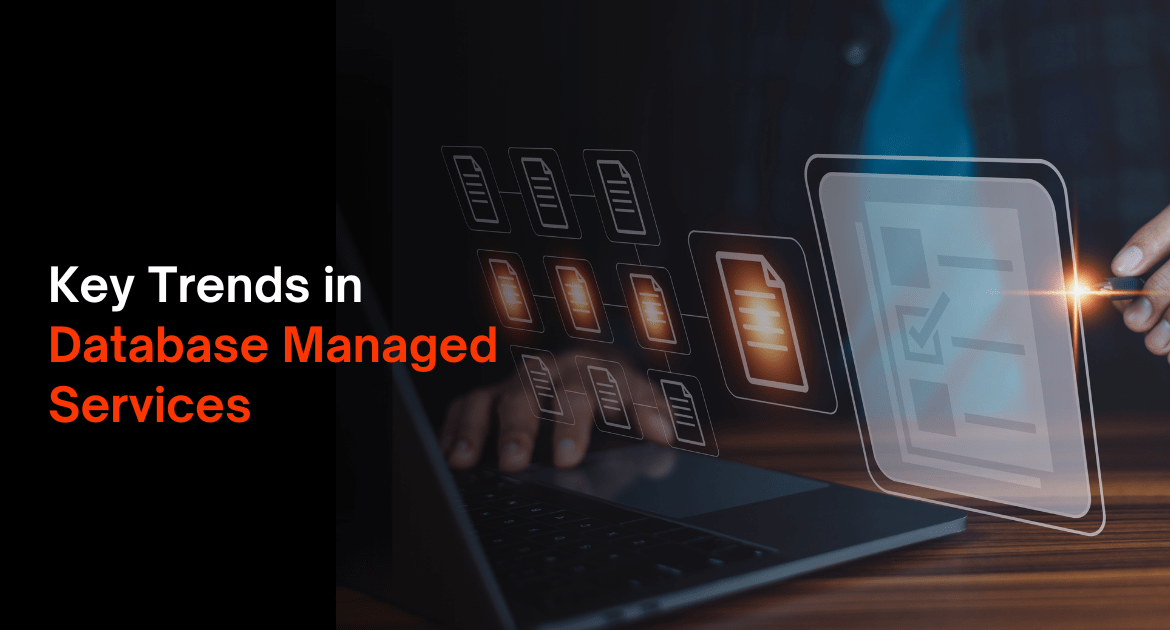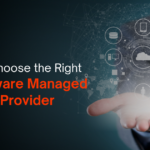Looking to optimize your data strategy and stay ahead in the digital age? This blog uncovers key trends in database managed services, including serverless management, hybrid cloud solutions, AI-driven optimization, and ethical data governance, and explores how these innovations can transform data handling for businesses. Find out how these developments may improve accessibility, security, and efficiency.
What Defines a Database?
A database is a structured collection of data that is organized, stored, and accessed electronically.
It serves as a repository for information, allowing users to efficiently store, retrieve, update, and manage data. Databases are essential for managing large volumes of data and are used in various applications, from business operations and financial systems to websites and personal data management.
Databases are managed by Database Management Systems (DBMS), which provide tools for data manipulation, querying, and administration. There are different types of databases, including relational databases, which use tables to represent data and their relationships, and NoSQL databases, which handle unstructured data and offer flexibility for modern applications.
What is Database Management Services?
In today’s digital world, data is everywhere. Businesses collect enormous amounts of information every day to make informed decisions. However, having a lot of data is only part of the equation. The real challenge lies in managing this data efficiently. That’s where database management comes in.
Database Management refers to the practice of storing, organizing, and maintaining data using specialized systems called Database Management Systems (DBMS). Think of it as a digital filing cabinet where all your business data is neatly organized and easily accessible. Just like a physical filing cabinet, a DBMS helps you keep track of your information, but it does it in a much more sophisticated way.
Why is this important? Well, for businesses to make smart decisions, they need accurate and up-to-date information. A good database management system provides this by helping business analysts quickly retrieve reliable data. This, in turn, helps in creating strategies that boost efficiency and productivity.
Different databases come with various features tailored to different needs. Therefore, it’s essential to evaluate and choose the one that best fits your business requirements. Whether you’re managing customer information, financial records, or inventory, having the right database management system ensures your data is organized, protected, and ready to support your decision-making process.

Future Trends in Database Managed Services for 2024 and Beyond.
In the rapidly evolving world of data management, staying ahead of the trends is crucial for businesses aiming to leverage their data effectively. From serverless database management to ethical data governance, the landscape of database managed services is transforming. Let’s delve into the key trends shaping the future of database managed services in 2024 and beyond.
The Rise of Serverless Database Management
-
Simplified Operations: Is Manual Database Maintenance Becoming Obsolete?
Imagine a world where IT teams no longer worry about provisioning and maintaining infrastructure. Serverless database management makes this possible by eliminating the need for manual intervention in these areas. Autonomous databases take it a step further by automating tasks like tuning, patching, and backups. This automation leads to streamlined operations and allows IT teams to focus on more strategic activities, driving innovation and efficiency within organizations.
-
Enhanced Scalability: How Does Serverless Database Management Handle Fluctuating Workloads?
One of the standout features of serverless platforms is their ability to automatically scale resources up or down based on demand. This means whether you’re running a small-scale application or handling massive traffic spikes, your database performance remains optimal without any manual adjustments. This dynamic scaling ensures cost-effectiveness and efficiency, making it a perfect solution for businesses with fluctuating workloads.
-
Cost Optimization: Can Pay-As-You-Go Models Revolutionize Database Costs?
With serverless database management, you only pay for the resources you use. This pay-as-you-go model ensures that costs are minimized while resource utilization is maximized. For businesses with unpredictable traffic patterns, this can result in significant savings, making high-performance database capabilities accessible without hefty upfront investments.
-
Real-World Applications
Netflix utilizes serverless database management to handle its vast streaming service. During peak times, such as evenings and weekends, Netflix automatically scales its database resources to manage high volumes of streaming requests. This ensures that users experience minimal buffering and downtime, providing a seamless streaming experience.
Hybrid Cloud Database Solutions: Bridging On-Premises and Cloud Environments
-
Flexibility and Choice: Can Hybrid Cloud Solutions Offer the Best of Both Worlds?
Hybrid cloud solutions offer the best of both worlds, allowing organizations to choose the most suitable environment for their specific workloads. Sensitive or legacy data can remain on-premises, while new applications or data-intensive tasks can utilize the scalability and cost benefits of the cloud. This flexibility ensures that businesses can optimize their operations without compromising on security or performance.
-
Data Locality and Security: How Do Hybrid Solutions Address Compliance Concerns?
Concerns about data sovereignty and regulatory compliance are addressed effectively with hybrid cloud solutions. By keeping sensitive data within specific geographical boundaries and leveraging cloud services for other functionalities, businesses can ensure data security while enjoying the benefits of cloud technologies. This balance allows organizations to maintain control over their data while optimizing their resources.
-
Progressive Migration: Is There a Smoother Path to Cloud Adoption?
Hybrid cloud architectures provide a gradual path from on-premises to cloud environments. Organizations can start by migrating specific workloads and slowly transition to a fully cloud-based setup at their own pace. This phased approach reduces risks and allows for a smoother, more controlled migration process, minimizing disruptions and ensuring a seamless transition.
-
Real-World Applications
NASA uses hybrid cloud solutions to manage its extensive data from space missions. While sensitive data like mission-critical telemetry is stored on-premises for security and compliance reasons, NASA leverages cloud services from providers like AWS and Azure for data analysis, simulations, and collaboration with international space agencies. This hybrid approach enables NASA to maximize data accessibility and computational resources while maintaining data sovereignty.
Predictive Analytics in Database Optimization: Leveraging AI and Machine Learning
-
Performance Monitoring: Can AI Prevent Database Bottlenecks?
AI-powered tools continuously monitor database performance metrics, identifying potential bottlenecks and anomalies in real-time. This proactive approach means that performance issues can be addressed before they impact users, ensuring a smooth and efficient database experience. By leveraging AI, organizations can maintain optimal performance and prevent downtime.
-
Query Optimization: How Does Machine Learning Improve Data Retrieval?
Machine learning algorithms analyze query patterns and optimize query plans, significantly improving query execution speed and reducing resource consumption. This ensures efficient data retrieval and minimizes database load, leading to faster and more reliable database performance. By automating query optimization, businesses can enhance user satisfaction and operational efficiency.
-
Capacity Planning: Can Predictive Analytics Anticipate Future Needs?
Predictive analytics models forecast future database resource requirements based on historical data and usage patterns. This allows organizations to proactively scale infrastructure, avoiding resource shortages and ensuring that database performance remains consistent even as demand grows. This foresight enables better resource allocation and prevents potential performance issues.
-
Anomaly Detection: Are Databases Becoming More Secure with AI?
AI algorithms can detect unusual database activity, such as suspicious queries or data access patterns, alerting administrators to potential security threats or data breaches. This enhances the security of the database, protecting sensitive information from unauthorized access. By implementing AI-driven anomaly detection, organizations can bolster their cybersecurity measures and safeguard their data.
-
Real-World Applications
Amazon applies AI-driven database optimization to enhance its recommendation engine. By analyzing customer browsing and purchasing behavior in real-time, Amazon’s database system predicts and updates product recommendations for individual users. This personalized approach increases customer engagement and sales conversion rates by presenting relevant products tailored to each user’s preferences
Blockchain-based Database Architectures: Enhancing Data Security and Transparency
-
Immutability and Traceability: How Does Blockchain Ensure Data Integrity?
Blockchain technology ensures that once data is recorded, it cannot be altered or deleted, creating a tamper-proof audit trail. This immutability enhances data integrity and transparency, making it ideal for applications where data accuracy and reliability are paramount. By leveraging blockchain, organizations can ensure that their data remains trustworthy and verifiable.
-
Enhanced Security: Can Decentralization Prevent Data Breaches?
The decentralized nature of blockchain technology eliminates single points of failure, making it highly resistant to attacks and data breaches. Cryptographic algorithms secure data transactions and access, ensuring that data remains confidential and intact. This robust security framework makes blockchain a valuable tool for protecting sensitive data.
-
Data Ownership and Control: How Does Blockchain Empower Users?
Blockchain technology empowers individuals and organizations with control over their data. Secure and transparent data sharing without intermediaries fosters trust and collaboration in data ecosystems, enhancing data utilization while maintaining privacy and security. This empowerment allows users to manage their data more effectively and confidently.
-
Auditability and Compliance: Is Blockchain the Future of Regulatory Adherence?
Blockchain-based databases provide a comprehensive audit trail of all data transactions, simplifying compliance with regulatory requirements and tracking data provenance. This promotes accountability and strengthens governance, making it easier to meet industry standards and regulations. By adopting blockchain, organizations can enhance their compliance efforts and ensure data integrity.
-
Real-World Applications
Walmart implements blockchain-based database architecture to enhance food traceability in its supply chain. Through IBM’s Food Trust blockchain platform, Walmart tracks the journey of fresh produce from farms to store shelves. This transparency allows Walmart to quickly trace the source of foodborne outbreaks, reduce food waste, and ensure the freshness and quality of its products, thereby improving customer trust and safety.
Edge Computing and Database Management: Enabling Real-Time Decision-Making
-
Edge Computing: How Does Proximity Enhance Data Processing?
Edge computing brings data processing and analysis closer to the source of data generation. This reduces latency and enables real-time decision-making, crucial for applications like autonomous vehicles, smart factories, and IoT devices. By processing data at the edge, businesses can improve responsiveness, efficiency, and user experience, unlocking new possibilities for innovation.
-
Local Data Management: Can Edge Databases Handle High Data Volumes?
Edge databases are designed to handle high volumes of data generated at the edge, providing local data storage and processing capabilities. This localized approach reduces the need to send data back to centralized cloud servers for processing, enhancing operational efficiency and reducing costs. By leveraging edge databases, organizations can streamline their operations and reduce latency.
-
Synchronization with Central Databases: How Do Edge and Central Databases Coexist?
Edge databases can synchronize with central databases, ensuring data consistency and enabling centralized analytics and reporting. This hybrid approach leverages the strengths of both edge and central databases, providing a robust and flexible data management solution. By integrating edge and central databases, businesses can achieve a balance between local processing and centralized oversight.
-
Real-World Applications
Tesla employs edge computing for its autonomous driving technology. Tesla vehicles process sensor data locally at the edge to make real-time decisions such as steering, braking, and accelerating without relying solely on cloud servers. This edge computing approach reduces latency, improves response times, and enhances the overall safety and reliability of Tesla’s Autopilot and Full Self-Driving capabilities.
Polyglot Persistence: Integrating Multiple Database Technologies
-
Data Variety: Why Use Different Databases for Different Data Types?
Organizations often need to manage diverse types of data, from relational and NoSQL to graph and time-series data. Polyglot persistence allows them to choose the best database technology for each data type, optimizing performance and efficiency for different applications. By using specialized databases, businesses can better handle the complexity of their data landscape.
-
Flexibility and Scalability: How Does Integration Support Evolving Needs?
Integrating different databases provides the flexibility and scalability needed to adapt to evolving data requirements and workload demands. This ensures that organizations have the right tools to handle specific data needs, whether it’s for transactional, analytical, or unstructured data. By adopting a polyglot approach, businesses can remain agile and responsive to changing demands.
-
Enhanced Performance: Can Specialized Databases Improve Efficiency?
Using specialized databases for specific data types allows organizations to achieve optimal performance and reduce bottlenecks. This ensures efficient data storage, retrieval, and processing, enhancing the overall performance of applications and services. By leveraging the strengths of each database type, businesses can maximize their data management capabilities.
-
Future-Proofing: Is Polyglot Persistence the Key to Staying Ahead?
Polyglot persistence enables organizations to leverage emerging database technologies and adapt to new trends without being locked into a single platform. This fosters innovation and agility, allowing businesses to stay ahead of the curve in a rapidly changing data landscape. By embracing polyglot persistence, organizations can future-proof their data strategies and maintain a competitive edge.
-
Real-World Applications
Twitter uses polyglot persistence to manage diverse data types across its social media platform. Twitter employs a combination of relational databases for user profiles and transactional data, NoSQL databases for real-time analytics of tweets and trending topics, and graph databases to analyze user interactions and relationships. This polyglot approach allows Twitter to handle massive data volumes efficiently, provide real-time updates, and deliver a personalized user experience.
 Ethical Data Governance: Ensuring Compliance and Privacy in Database Services
Ethical Data Governance: Ensuring Compliance and Privacy in Database Services
-
Data Privacy and Security: How Can We Protect Sensitive Information?
In an era where data breaches and privacy concerns are prevalent, robust security measures are essential to protect sensitive data. Database service providers must adhere to industry standards, implement data encryption, and establish access control mechanisms to prevent unauthorized access and ensure data security. By prioritizing data privacy, organizations can build trust with their users and stakeholders.
-
Transparency and Accountability: Why Is Ethical Data Usage Important?
Organizations must be transparent about how they collect, use, and share data. This includes providing clear privacy policies, obtaining informed consent from data subjects, and offering mechanisms for data access and control. Transparency builds trust and ensures that data is used ethically and responsibly. By fostering accountability, businesses can enhance their reputation and customer loyalty.
-
Data Governance Frameworks: What Role Do They Play in Ethical Management?
Establishing comprehensive data governance frameworks is crucial for managing data ethically and responsibly. This includes defining data ownership, access rights, data quality standards, and compliance procedures. A strong governance framework ensures that data is managed effectively, protecting both the organization and its stakeholders. By implementing robust governance practices, businesses can mitigate risks and ensure compliance.
-
Data Ethics Training: How Can We Foster a Responsible Data Culture?
Training employees on data ethics and compliance is essential to foster a responsible data culture. Ensuring that everyone understands their role in protecting data privacy and adhering to ethical guidelines is crucial for maintaining the integrity and security of the database. By investing in data ethics training, organizations can promote ethical behavior and safeguard their data assets.
-
Real-World Applications
Apple prioritizes ethical data governance to protect user privacy across its ecosystem. Apple’s database management practices include stringent encryption protocols for user data stored on iCloud, strict access controls to prevent unauthorized data access, and transparent user consent mechanisms. These measures ensure that user data remains secure and private, building trust with millions of Apple users worldwide.
Wrapping Up –
Innovations that increase productivity, fortify security, and enhance accessibility will determine the direction of database services in the future.
To fully utilize these developments, organizations need to remain flexible in handling anything from sophisticated serverless administration to moral data management. Adopting these innovations guarantees an advantage in the digital age and improves data strategies while stimulating creativity.
Our specialty at Simple Logic IT is database administration services that maximize effectiveness, support security, and improve accessibility. Keep up with us as we tackle serverless management and ethical governance.
Seize the opportunity to innovate and make sure the shift to scalable solutions is smooth. Discover how you can improve your operations and keep your competitive advantage in the digital world with our experience in cloud automation with Simple Logic IT.
FAQs About Top Database Management Trends 2024
- How can I align my data governance policies with evolving global data privacy regulations?
Regularly update policies, use automated compliance tools, and consult legal experts.
- How do I assess the long-term scalability of serverless database solutions for my growing business needs?
Assess provider scalability, automatic scaling features, and pilot test for real-world scenarios.
- What are the hidden costs or potential pitfalls of adopting advanced database technologies?
Consider maintenance fees, training costs, integration challenges, and migration issues.
- How does blockchain technology enhance data security and transparency in database management?
Blockchain provides immutable records, cryptographic security, decentralized consensus mechanisms, and transparent audit trails, enhancing trust and data integrity.
- What are the key benefits of implementing serverless database management systems?
Serverless databases reduce operational overhead, offer automatic scaling, and allow for cost-efficient resource utilization.
-
Can blockchain be utilized for decentralized data storage in database management?
Blockchain enables decentralized data storage, enhancing security and reducing single points of failure.









